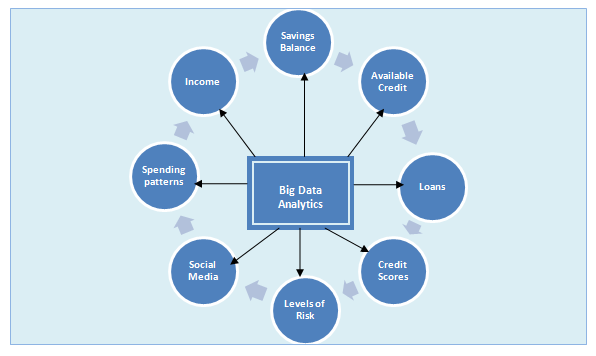In today’s digital age, data is more abundant than ever before. Every action we take online, every transaction we make, and even how we interact with the devices around us generates data. This large volume of data, known as Big Data, is reshaping how businesses operate and make decisions. But what exactly is Big Data, and why is it so important for modern businesses?
In this article, we will explore the concept of Big Data, its characteristics, and how businesses can leverage it to gain a competitive edge, improve customer experiences, and make better, data-driven decisions.
What Is Big Data?
Big Data refers to large and complex sets of data that traditional data processing software can’t handle efficiently. The sheer volume, variety, and speed at which this data is generated require advanced tools and technologies to process and analyze it.
Big Data comes from various sources, including:
- Social media (likes, shares, comments)
- Transactional data (purchase history, credit card activity)
- Sensor data (data from IoT devices like smart home devices, wearables, or industrial sensors)
- Customer interactions (customer service inquiries, chatbots, feedback forms)
- Public data (weather reports, government databases)
The 3 Vs (Volume, Variety, and Velocity) are often used to define Big Data:
- Volume: Refers to the massive amounts of data generated every day. For instance, over 2.5 quintillion bytes of data are created daily, which is equivalent to more than 100 million hours of video.
- Variety: The data comes in many formats, including structured (like databases), semi-structured (like XML files), and unstructured (like social media posts and images).
- Velocity: The speed at which data is generated and processed. With the rise of real-time analytics, businesses can now make faster decisions based on live data streams.
Beyond these core attributes, some experts also mention Veracity (uncertainty of data) and Value (usefulness of data) as additional components that define Big Data.
Why Is Big Data Important for Modern Businesses?
Big Data has revolutionized industries by enabling businesses to harness and analyze vast amounts of data in real-time, leading to improved decision-making, innovative products, and more personalized customer experiences. Here are some key reasons why Big Data is so crucial for modern businesses:
1. Improved Decision-Making
The ability to analyze large datasets gives businesses a much clearer picture of market trends, customer behaviors, and operational performance. Big Data tools allow decision-makers to access real-time insights and make data-driven decisions that can significantly improve business outcomes.
For example:
- Retailers can analyze purchasing patterns and optimize inventory management.
- Financial institutions can assess credit risk and detect fraud in real-time.
- Healthcare providers can analyze patient data to improve treatment protocols.
By using data to inform decisions, businesses can reduce guesswork and make more accurate predictions about the future, leading to more efficient operations and higher profits.
2. Personalized Customer Experience
Big Data allows businesses to understand their customers on a deeper level. By analyzing data such as past purchases, browsing behavior, social media interactions, and even sentiment analysis from customer feedback, businesses can create highly personalized products, services, and marketing campaigns.
For instance:
- E-commerce platforms like Amazon recommend products based on your browsing and purchase history.
- Streaming services like Netflix and Spotify use Big Data to suggest movies, TV shows, or songs based on your past preferences.
This personalization leads to increased customer satisfaction, loyalty, and higher conversion rates.
3. Predictive Analytics
With Big Data, businesses can not only look at historical data but also predict future trends and behaviors. Predictive analytics uses statistical algorithms and machine learning techniques to forecast future outcomes based on historical data patterns.
For example:
- Retailers can predict which products will be in high demand during certain seasons and stock up accordingly.
- Insurance companies can predict the likelihood of claims based on customer profiles and adjust their policies or pricing models accordingly.
- Healthcare providers can predict patient needs, such as when a person might require specific treatments or medications.
By predicting trends and outcomes, businesses can proactively take actions to optimize their operations, improve customer service, and even avoid potential risks.
4. Cost Reduction and Efficiency
Big Data analytics helps businesses improve operational efficiency, streamline processes, and reduce costs. By analyzing data across the supply chain, operations, and workforce, businesses can identify bottlenecks, inefficiencies, or areas where cost-saving measures can be implemented.
For example:
- Manufacturing companies use Big Data to monitor production lines in real-time, identifying issues that may lead to costly downtime or defects.
- Logistics companies can optimize routes, saving on fuel and reducing delivery times.
- Energy companies can analyze data from smart meters to optimize energy consumption and reduce operational costs.
In essence, Big Data enables businesses to eliminate waste, improve productivity, and ensure resources are being utilized in the most cost-effective way.
5. Real-Time Insights and Actionable Data
The velocity of Big Data means that businesses can analyze data in real time, allowing them to respond immediately to changing conditions. For instance, retailers can adjust pricing in response to competitive actions, or companies can respond instantly to customer feedback on social media.
For example:
- Airlines can use real-time data to track flight delays and immediately update passengers with the latest information.
- Social media platforms can adjust content and advertisements based on user behavior and real-time interactions.
This real-time data analysis allows businesses to stay agile, adapt to customer needs quickly, and stay ahead of competitors.
6. Innovation and New Product Development
Big Data enables businesses to uncover insights that lead to the creation of innovative products and services. By analyzing consumer preferences, market trends, and feedback, companies can identify unmet needs or gaps in the market and develop new solutions to address them.
For instance:
- Automakers use Big Data to monitor vehicle performance and create smarter, more energy-efficient cars.
- Tech companies use data from user interactions to improve software features and develop new applications.
- Food companies use data to track consumer tastes and trends, leading to the launch of new flavors or healthier alternatives.
Through data-driven insights, businesses can stay at the forefront of innovation and offer products that align with market demands.
7. Competitive Advantage
With the wealth of insights Big Data provides, businesses can gain a significant competitive advantage. Companies that can analyze data effectively are better positioned to understand customer needs, optimize operations, and predict market shifts.
For example:
- Retailers who leverage Big Data for pricing and inventory management can respond faster to demand changes than their competitors.
- Financial institutions using Big Data to detect fraudulent activity in real time can prevent losses and maintain customer trust.
- Tech startups can use Big Data to gain insights into user behavior and improve their apps, ensuring they stay ahead of competitors.
By leveraging Big Data, businesses can differentiate themselves in the marketplace, making them more agile, efficient, and responsive to change.
8. Enhanced Marketing Strategies
Marketing is one of the most significant areas where Big Data plays a crucial role. By analyzing customer demographics, preferences, and behaviors, businesses can create targeted marketing campaigns that yield higher returns on investment (ROI). Big Data helps companies identify the right audience, the best time to reach them, and the most effective marketing channels.
For example:
- Online advertisers can use Big Data to create personalized ads based on browsing history and demographic information.
- Email marketers can segment their lists and send personalized offers based on customer preferences and past behavior.
- Retailers can send targeted promotions to customers based on their purchasing patterns.
These data-driven marketing strategies can lead to better engagement, higher conversion rates, and more effective customer acquisition.
How Do Businesses Leverage Big Data?
To leverage Big Data effectively, businesses must invest in the right technologies, tools, and platforms. Here are some ways businesses can put Big Data to work:
- Data Warehousing: Collect and store vast amounts of data in central repositories for easy access and analysis.
- Data Analytics Tools: Use software and platforms that can process and analyze Big Data, such as Hadoop, Spark, and machine learning algorithms.
- Cloud Computing: Use cloud-based services to scale data storage and processing capabilities without having to manage the infrastructure.
- Data Visualization: Present data insights in visual formats, such as charts and graphs, to make it easier for decision-makers to interpret and act upon the information.
As businesses collect and analyze more data, they can continually refine their strategies and become more efficient, customer-centric, and competitive.
Conclusion
Big Data is no longer a luxury for modern businesses; it has become a necessity. With the volume, variety, and velocity of data increasing rapidly, businesses that fail to leverage Big Data risk falling behind their competitors. On the other hand, companies that can harness and analyze this wealth of information can make smarter decisions, deliver more personalized experiences, and innovate faster.
In today’s fast-paced business environment, Big Data is an essential asset for growth and success. By investing in the right tools and technologies, businesses can gain insights that will help them stay ahead of the curve, reduce costs, enhance customer satisfaction, and ultimately thrive in an increasingly data-driven world.

